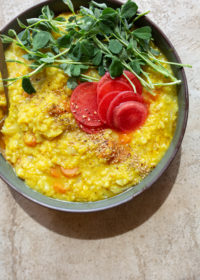Ayurveda: Rasa – The Six Tastes of Ayurveda | Sour
This guest post from Adena Rose Ayurveda is part of a six part series on the essential tastes of Ayurveda – catch the other 5 tastes here!
Right around the holidays, I wrote a post featuring the Sweet taste, Madhura. I introduced the idea of how to use food as medicine according to Ayurvedic principles. Food is more than fuel. Any substance becomes medicinal (or poisonous to our well-being) when we understand its qualities – these qualities tell us how it’s going to affect our mind and body, whether it will bring us into balance, or further out of whack. How can we know? Well, patience and practice, but also through our tongue – taste.
To repeat some of what I said in the introductory post, in order for us to stay balanced physically, mentally and emotionally, we need to be balanced in the qualities we take in. Each of the tastes is a signifier to us how the substance will affect our bodies, and the maha gunas (sattva, rajas and tamas) which govern our state of mind.
Ayurveda explains that there are six tastes: Sweet, Sour, Salty, Pungent, Bitter and Astringent. Some of these may seem obvious, and others enigmatic. Each of the tastes is also comprised of the five elements, two which are the most dominant. This means that the tastes affect the doshas, Vata, Pitta and Kapha, which are also made of the 5 elements. You can use the chart below to see which tastes ‘subdue’ which doshas, and which elements each taste contains. In Ayurveda, like increases like. If we want to lessen the effects of a dosha which is showing up as too high, we will eat foods with the tastes that have elements which are not the same as those in the dosha which is out of whack – those ‘subdue’ the dosha.


Beyond the tastes, of course we want to ingest food full of prana, the life-force energy, and we also want to be sure we are chewing our food slowly, and digesting it fully. Those topics are beyond this post for now, but you can find general Ayurvedic tips for optimal digestion here.
Amla : Sour
Fire and Earth elements predominate in the Sour taste. Sour is a familiar taste to us – we all know that lip-puckering, face-squeezing suction action that happens when we bite into a fresh lemon. Lovely! Fire being a dominant element in Sour, sour taste can be used in moderation to boost our agni, our digestive ability. Sour is meant to be a condiment, or a lesser piece to a meal, to aid in digestion and add flavor. The sour taste is said to increase our absorption of nutrients and minerals like iron, stimulate circulation and elimination, strengthen the heart, energize the body and sharpen the senses.
Sour, consisting of mostly fire and earth, balances Vata dosha best. Sour condiments stimulate agni, improving and warming digestion in Vata-types, who benefit from extra warmth and stimulation of their digestive fluids. As you have experience if you’ve bitten into a lemon, the sourness causes a suction (earth/gravity) but then this stimulates the secretion of saliva to disperse the intense taste. This is how sour stimulates digestive juices. This also means though, that too much sour aggravates Pitta and Kapha doshas. The heavy, moist quality of the Earth element is what can aggravate Kaphas, though it is less aggravating to Kaphas than to Pitta. I am sure to avoid sour in the case of an acute Kapha imbalance, like a head cold, but otherwise, Kapha’s can actually benefit from the sour tastes stimulating qualities in small amounts.
Fire dominates in sour, and fire dominates in Pitta dosha. Pitta types are those who tend to have pretty good digestion in general: those who get really hungry (even hangry – angry/hungry – if you will), who have light, sensitive skin, who are prone to overheating, rashes or redness, who turn frustrated or angry rather than sad, who are competitive or judgmental at their worst, or have loose bowel movements when stressed. Increasing fire in a Pitta type, does not usually serve them. The intensity of sour increases the intensity inherent in a Pitta type or imbalance, and though they may crave it, it’s not a healthy craving to indulge for those experiencing any of the above symptoms – it will only exacerbate them. A pitta imbalance can happen in any of us, especially during the heat of Summer, when as you can imagine, Pitta is highest in our environment, and even during ovulation for women, when pitta is dominant in our cycle.
Sweet, salty and sour, the tastes which balance Vata, are dominant in a lot of our comfort foods – or at least those foods we grab when we need comfort. If we grab a bag of salt and vinegar chips, or a jar of pickles when we’re frustrated, or go for a few beers to relax after a frustrating day at work in July (not saying there is anything wrong with this – it’s just about balance) we are in a place to upset Pitta. This could manifest as acid reflux or belching, or waking up with a really sharp headache right behind the eyes. This could also show up as a skin rash the next day, and we have ‘not idea’ where it came from. This is an overindulgence in sour, making it the main part of our ‘meal’ rather than a condiment to stimulate digestion. When you’re in good health and balanced, 1 pickle, or 1 glass of beer or a kombucha along with a meal would be a more beneficial use. And again, it’s all up to the individual and their current state.
So where can you find the sour taste? I mentioned a few above, but you can certainly find the sour taste in fermented foods like kombucha, sauerkraut, kimchi, pickles, and yogurt. Sour fruits are also more obvious, like citrus, cranberries, raspberries and many other fresh berries, tart cherries and not so ripe pineapples. Banana and peaches are also considered sour, actually, and so is garlic (it contains all tastes, really) and tamarind. Vinegar is sour and a common condiment, so is tamari (along with salty), and wine and beer are considered to have a sour effect on the body as well. In small amounts these beverages can aid digestion of a meal, but in amounts much larger than ½ glass, the alcohol aggravates pitta and the liver, and can actually can impede good digestion.
One of these foods which may be confusing is yogurt. A bowl of plain yogurt fresh from the fridge is heavy and cold, though once ingested, can aggravate both Kapha and Pitta, and cause burning or acid reflux. Yogurt should not be eaten too cold, and should always be lightly spiced – even simply stirring some cardamom and cinnamon or ginger powder in can help. Ayurveda talks of using yogurt to aid digestion in the form of a lassi – a lightly spiced, watered down, and sweetened plain yogurt ‘shake’ to be taken as a digestive aid after meals. Mango lassi (though oh so delicious) is considered a poor food combination, because fruit and milk together are difficult to digest, and can form toxins. An Ayurvedic lassi usually involves 1 part yogurt to 3 parts water, cumin or coriander powder, a bit of sweetener, and rose water, blended together.
Medicinally, the sour would be used mostly as a food, as a condiment to help stimulate digestion, mostly for Vata-types or imbalances, as mentioned above. Squeezing from fresh lemon or lime juice on top of your lunch is a great way to use sour. Think about the usual salad dressing – vinegar can helps us digest those raw, leafy greens.
It is worth mentioning one of the most famous sour Ayurvedic ‘herbs’: amalaki. Amla, sour, is right in the name of this light green fruit native to India. Half of the reason (this is not really much of an exaggeration) I went to India to study was to taste fresh amla. Amalaki is actually said to contain all of the tastes except salty – though sour predominates. Its post-digestive effect is sweet, so it actually nourishes the tissues, as well as aids agni and cleansing. Amalaki is often used in high Pitta issues, while in general sour foods aggravate Pitta. Amalaki is one of the three fruits which makes up the common formula, triphala (‘3 fruits.’)
As always with Ayurveda, it is a personal exploration. There are so many subtleties to these ‘rules,’ and each of us is an individual expression of the elements. It’s all part of the practice, your sadhana, to find what can best bring you true peace, health and sanity.
—————
Adena Rose Harford is a NAMA Certified Ayurvedic Practitioner and AyurYoga Specialist offering Ayurvedic Lifestyle Consultations, meal planning and cooking lessons, guided cleansing, Ayurvedic bodywork, and yoga instruction in Vermont. Her 7-day ayurvedic cleanse is available online. If you’re interested in learning more about Ayurveda, follow Adena Rose Ayurveda on Facebook for Ayurvedic tips, recipes and remedies.
 [wpmenucart]
[wpmenucart]




mortgagecrow.com I cannot thank you enough for the article post.Really thank you! Great.
Great, thanks for sharing this blog article.Much thanks again. Cool.
[…] you catch Sweet and Sour? No, it’s not a new Asian soup-virus, I’m referring to my previous two guest posts here […]
Hi my name is Patricia Egan you can reconend to do , I diagnostic stomac cancer , what I can drink or do , can you help me pls,